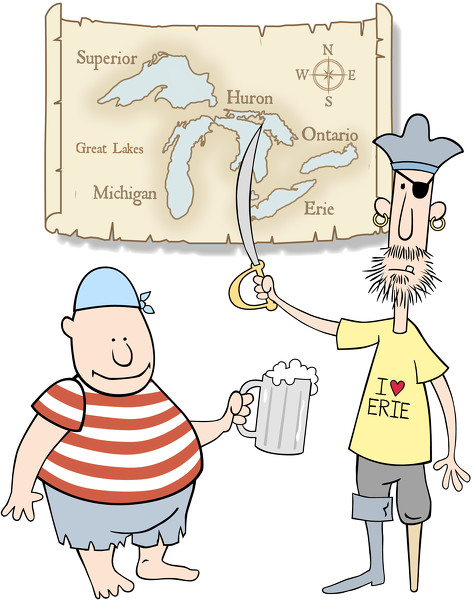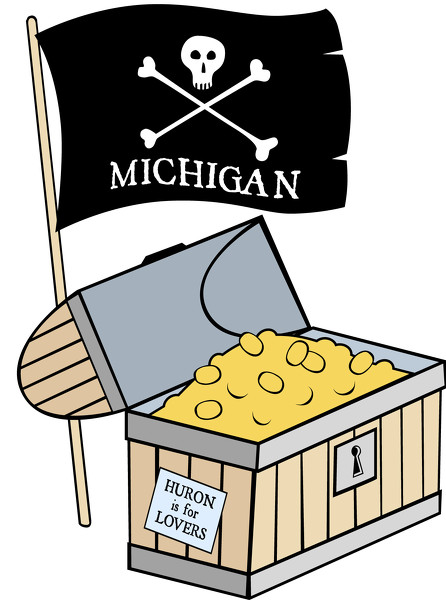Saturday, June 11th, 2022
Pirates on the Great Lakes
By Leslie Gartrell

Photo by Bill Thornbro/The Daily Standard
Less famous than their Caribbean brethren, Pirates of the Great Lakes plied their trade in centuries past.
ST. MARYS - The word "pirate" usually evokes images of swashbuckling, eyepatch-wearing, peg-legged and parrot-wielding buccaneers who traveled the high seas.
However, pirates could be found much closer to home - most notably the Great Lakes.
Ellen Kennedy, education and visitor experience director for the National Museum of the Great Lakes, spoke Tuesday at the St. Marys Public Library about the history of piracy on the Great Lakes.
"There was piracy on the Great Lakes," she said. "There was a lot of different kinds of maritime crime that historically would have been lumped together as piracy."
The golden age of piracy from the 16th century into the 18th century served as inspiration for much of the lore around piracy that exists today, Kennedy said.
Piracy flourished during the era, Kennedy said, which was a time when developing nations and cities were ballooning in size and wealth. These nation states were starting to explore and expand their empires, she said. Subsequently, none of these nation states truly had the power to control the sea.
"So there was this sort of development of piracy, because of the opportunity as well as because of the different resources that were being shipped across the oceans as well," Kennedy said. "You've had Spanish gold ships, you had rum. You had these products that were easily able to be sold for profit. And so it really led to piracy, not just in the Caribbean(but) sort of all over the world."
Nations at the time used privateering, which Kennedy said equates to government-sanctioned piracy, to attack other governments in the wars and battles that broke out during this time of expansion.
"So it was really creating this environment where piracy was profitable, as well as sanctioned by governments," she said. "Then when those wars ended, when those opportunities ended, these pirates were no longer getting the letter of marque, the document that said that they were a sanctioned privateer by their own government."
Without the backing of their government, it was much more profitable for the seamen to continue illegal activity, Kennedy said. This is when some infamous characters such as Blackbeard began to take hold as piracy spread across the Caribbean, she said.
However, piracy began to wane in the 18th century as nation states became more organized and powerful. At the same time, a book by Captain Charles Johnson called "A General History of the Robberies and Murders of the Most Notorious Pirates" was published in 1724, she said.
Kennedy said the book was influential in shaping the popular concept of pirates and gave an almost mythical status to some of the most famous pirates of the golden age, among them Anne Bonny, Blackbeard and Bartholomew "Black Bart" Roberts.
Around the same time the golden age of piracy was coming to an end, Europeans were discovering the Great Lakes region, Kennedy said. Many French explorers were drawn to the area and the region became well known for its fur trade.
After the Revolutionary War, Kennedy said the U.S. government's main source of income was tariffs. To keep smugglers from dodging the tariffs, the U.S. created the Revenue Cutter Service in 1790. It enforced maritime law in U.S. waters, including the Great Lakes.
"That meant chasing down things like timber thieves and cargo hijacking pirates, putting down the occasional rebellion," she said.
At any given time, Kennedy said the Great Lakes would have 10 to 12 different RCS ships operating across the Great Lakes as part of the Great Lakes Patrol.

Photo by Bill Thornbro/The Daily Standard
Less famous than their Caribbean brethren, Pirates of the Great Lakes plied their trade in centuries past.
At the center of the patrol was the USS Michigan, the only naval vessel on the Great Lakes, she said. The USS Michigan began its service in 1844.
"It was really influential in enforcing the tariffs and stopping smugglers and stopping piracy all across the Great Lakes," she said of the ship.
The USS Michigan played a role in several iconic moments in history, Kennedy said. One such moment was the arrest of James Strang.
Strang led a colony of Mormon dissenters on Beaver Island in Lake Michigan, which was already occupied by fishermen and fishing communities before Strang and his colony invaded, Kennedy said.
Strang declared himself king, and the local communities began accusing Strang and his group of theft and piracy, she said.
Hearing the word "king," the federal government began investigating. Strang was arrested, Kennedy said, but was able to talk his way out of charges.
He later became a state congressman for a little while, she said, before he was ultimately assassinated by two of his former followers on the docks of Beaver Island.
In 1853, the USS Michigan was called to stop what was later called the Timber Rebellion. Timber was one of the most important resources at the time, Kennedy said. Due to its size, timber cargo was difficult to steal.
However, it was also difficult to tell who owned the timber. So-called timber pirates would steal timber from land as well as cargos-worth of lumber, she said.
"Part of the timber rebellion was a little bit of a push back against what the locals saw as federal overreach," Kennedy explained. "There were vast forests up in the Upper Peninsula of Michigan or through Minnesota and Wisconsin, that the federal government had earmarked for their own use for their own naval ships.
"And so the locals were really pushing back against that and stealing the timber for their own use as well. They even burn boats loaded with logs in Grand Haven in what they sort of were calling a reenactment of the Boston Tea Party."
Smuggling began to pick up again during Prohibition, Kennedy said. RCS had merged with the Life Saving Service and eventually became the Coast Guard, which took over the role of stopping smugglers and performing lifesaving tasks, she said.
Kennedy said it was estimated that 75% of illegal alcohol came from Canada across the Great Lakes during Prohibition. Smuggling wasn't easy, as its practitioners had to pass through the Detroit River to Lake St. Clair and then to the St. Clair River, which is the narrowest space between the United States and Canada, she said.
"If you could get across without being caught and get away, you were able to disappear with your goods," she said. "And so part of the rise in the popularity of the speedboat was coming from the smugglers finding faster and faster engines."
Among the most notorious pirates of the Great Lakes was Dan Seavey, who started out as a sailor but turned to piracy after leaving the military.
Seavey had eyes for large shipments of venison and alcohol, which he would later sell at a higher price. He also was known for putting up fake lights that simulated a port so that incoming ships would crash on the rocks and he could steal their cargo, Kennedy pointed out.
Seavey's most famous escapade was his takeover of a schooner named the Nellie Johnson, Kennedy said. Seavey invited the Johnson's crew to drink with him and then threw the drunken sailors off their ship and sailed it to Chicago, where he sold the Nellie Johnson's cargo. He later became a U.S. marshal to help fight Prohibition in the 1920s, she said, saying some believe he was actually selling liquor on the side.

